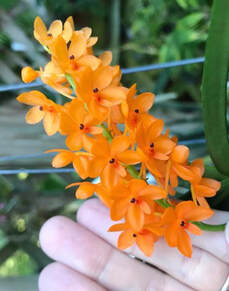|
Better-GroOrchidBlog
 It's likely that you have stopped to admire a Vanda at your local garden center or even seen them growing in a greenhouse or your neighborhood. These eye-catching orchids certainly attract attention. Less common than Phalaenopsis and Cattleya orchids, Vandas require slightly different care than other orchid varieties, but they are well worth the effort!  Blossoms Vandas are showy, long-lasting, frequent bloomers. They are very rewarding to grow and often times fragrant. Prized for their intense colors, they are commonly available in hot pink, orange, red and purple. The Vanda genus also includes a species with vibrant blue flowers called Vanda coerulea or the Blue Orchid (shown right). Unlike many other orchids that bloom just once a year, healthy Vandas can bloom throughout the year.  Leaves and Types Vandas are different from Cattleyas and Oncidiums in that they don’t have pseudobulbs. Water is retained in the plants' leaves which is why they need to be watered more frequently. Vandas come in three types and are easily distinguishable by looking at the plant's leaves.
 Vanda Origins Their natural habitat ranges from India and the Himalayas to China, the Philippines and New Guinea. A few species are found in the Western Pacific Islands and Queensland, Australia. Most species in the Vanda genus are epiphytes, meaning they grow on other plants without harming the host plant. By clinging to trees, Vandas have access to more sunlight versus growing on the forest floor, while still being shielded from direct sunlight by the tree canopy. In addition to growing in trees, some Vandas are lithophytic which means the grow on rocks, and some are terrestrial (grow on the ground).  Plant Size Vandas come in many sizes. Some are tiny and can fit in the palm of your hand whereas others can grow up to 6 feet tall. Individual flowers range in size from less than an inch to four inches. They grow in clusters with up to 15 flowers per stem. Vandas are easily recognizable from other orchids due to their long, rambling roots that enable the plant to cling to trees. Often times, you will find Vanda roots growing two to four feet below the plant. Vandas are unique in that they do not grow in traditional orchid plant media like fir bark and charcoal.  Caring for Vandas If you are interested in learning more about the ideal conditions for growing Vandas, please visit our Vanda Care Instructions on the Better-Gro website. There you will find recommendations for temperature, light, watering, feeding and humidity. We hope you will consider bringing home your own Vanda in the future. Please send us your photos on Facebook, Instagram and Twitter with the hashtag #BetterGroBlooms. Happy Blooming from Better-Gro!
Comments are closed.
|
Resources
|
Company |
|
